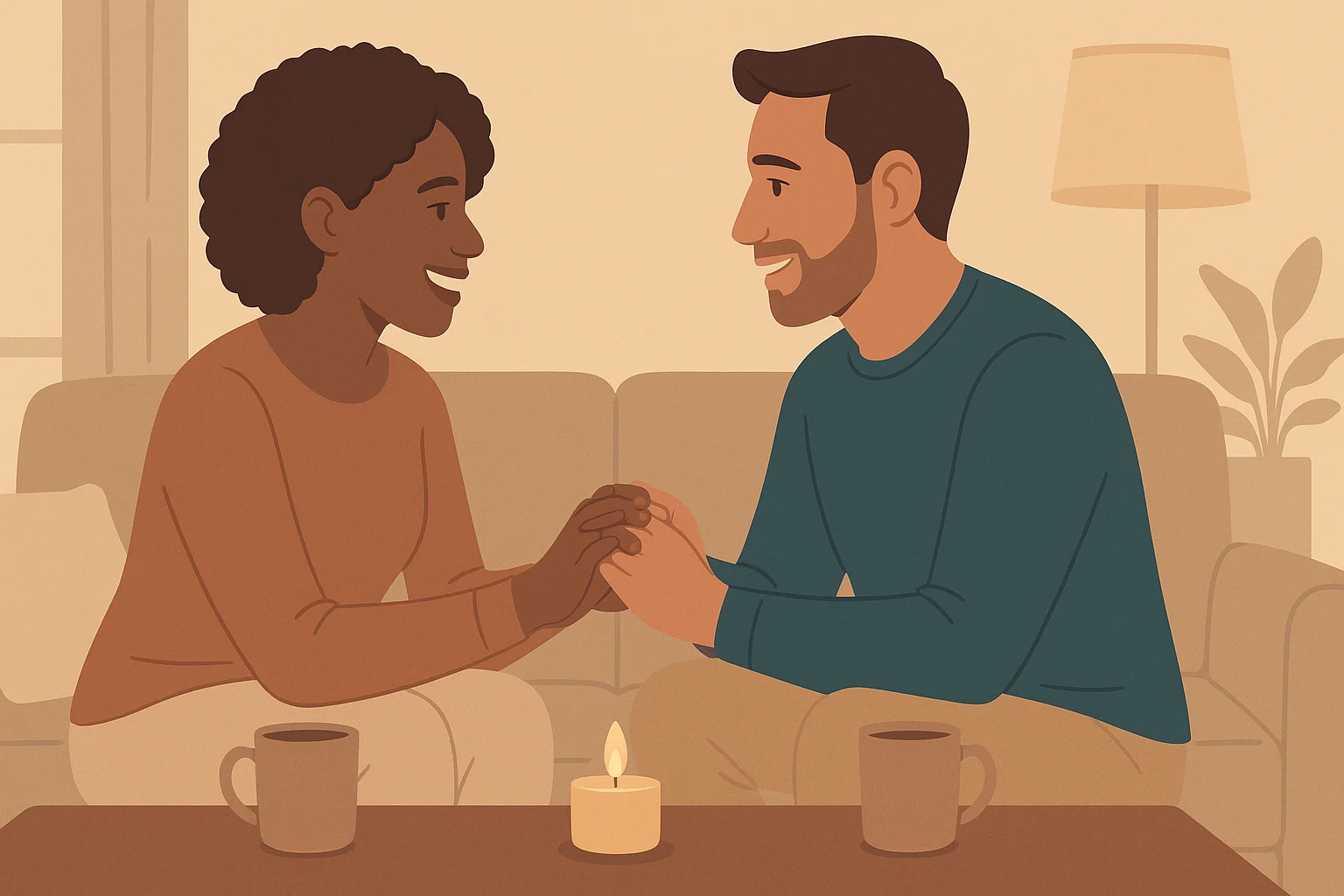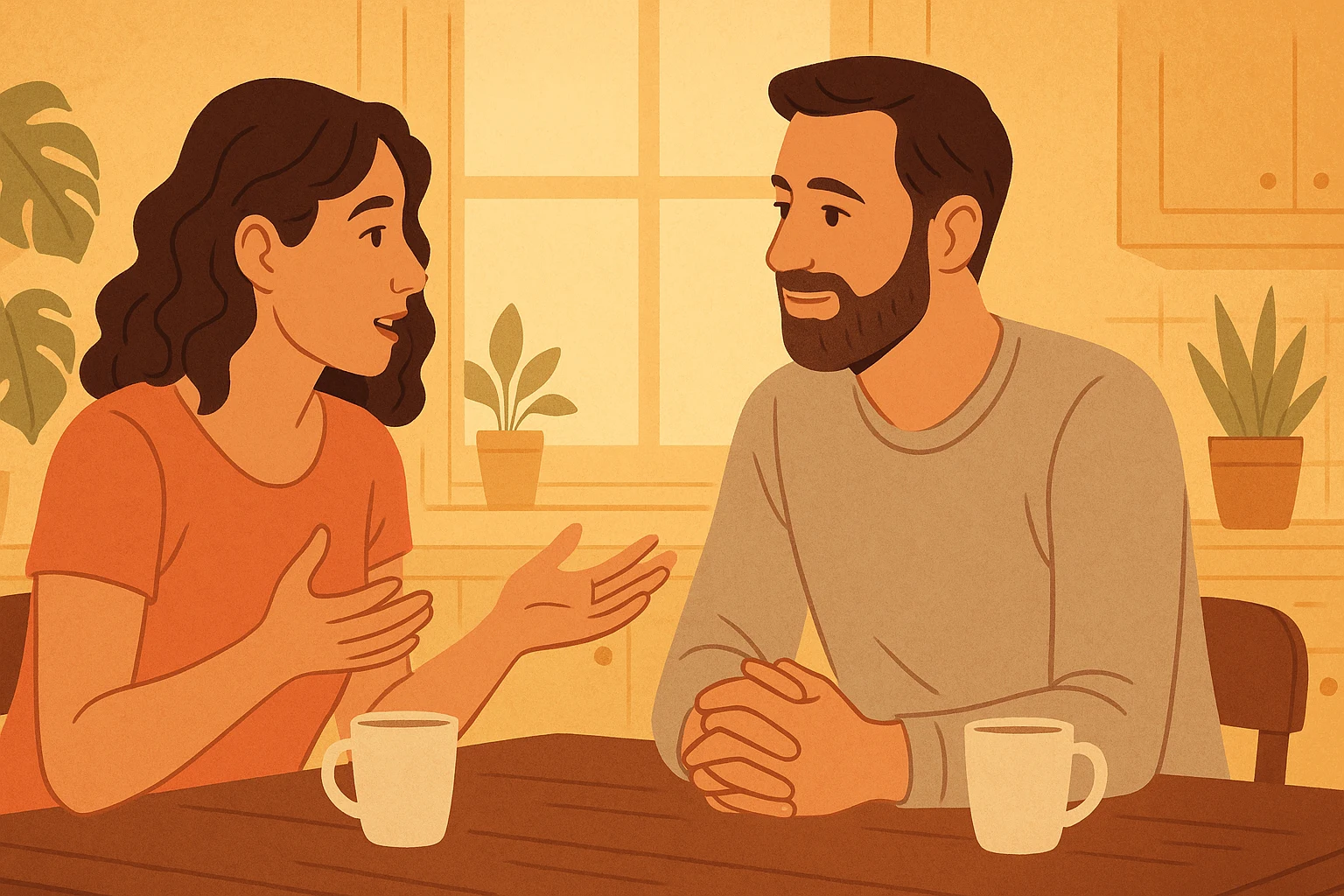
Feeling a bit off in the bedroom? This woman’s guide to sexual education for couples can help you turn intimacy into a shared adventure. For lots of women, figuring out sexual relationships can feel like trying to find your way in the dark. By embracing couples sexual wellness and exploring our women’s relationship wellness, you can take the lead, building a deeper bond, trust, and joy with your partner. This guide gives women practical tools to enrich their love life through honest talks, mutual respect, and ongoing discovery, with benefits that ripple way beyond the bedroom.
Find your current vibe in 10 seconds. Tap a button and get a tailored micro-tip you can try tonight.
Table of Contents
- Key Takeaways from Sexual Education for Couples
- Why It Empowers Women
- Sexual Education for Couples: Understanding Your Body
- Decoding Consent for Couples
- The Art of Communication in Relationships
- Pleasure Mapping: A Fun Step for Couples
- Adapting Intimacy Through Life’s Changes
- Overcoming Challenges in Intimate Learning
- Frequently Asked Questions About Sexual Education for Couples
- Conclusion: Embrace Couples’ Sexual Wellness
Key Takeaways from Sexual Education for Couples
- Communication Drives Intimacy: Honest conversations about desires and boundaries are the cornerstone of sexual education for couples.
- Knowledge Builds Confidence: Understanding anatomy, pleasure, and consent empowers both partners for a more fulfilling experience.
- Intimacy Evolves Over Time: Embracing curiosity keeps the spark alive as sexual relationships change.
- Respect Strengthens Bonds: Learning together creates a safe space where both partners feel valued and heard.
- Exploration Enhances Connection: Engaging in couples’ intimacy education as a team deepens emotional and physical bonds.

Couples Sexual Wellness: Why It Empowers Women
I’ve learned that diving into sexual wellness as a couple opens up so much more than just biology—it’s about pleasure, connection, and growing closer. Here’s how it can change things for the better:
- Empowerment Through Knowledge: Getting to know your body and what you enjoy gives you the confidence to speak up for what you want.
- Closing the Pleasure Gap: Putting your pleasure first creates a more balanced and satisfying experience for both of you.
- Strengthening Relationships: Learning together builds trust and opens up a deeper emotional connection.
- Boosting Confidence: Knowing your body and how your partner responds makes you feel at ease, in and out of the bedroom.
- Support Emotional Ease: Clearing up myths about sex can help reduce worries and make conversations feel more natural.
Honest, open talks are the heart of a vibrant love life.
By taking charge of your sex education as a couple, you can shape a more fulfilling intimate life.
Sexual Education for Couples: Understanding Your Body
Discovering what brings your body joy is a meaningful step before sharing your desires with your partner. This key step in intimacy education for couples starts with really getting to know yourself.
Exploring Female Anatomy for Pleasure
You probably know the basics, but diving into what feels amazing is a whole new adventure:
- Clitoris as a Key Area: It’s rich with nerves that can enhance pleasure with gentle stimulation.
- Vaginal Sensitivity: Different depths and pressures may feel pleasurable, and the G-spot, for some, is a unique area of sensitivity.
- Whole-Body Magic: Your neck, ears, or thighs can get you tingling, turning pleasure into a full-body vibe.
This post has affiliate links. We may earn a commission. Learn more.
The Benefits of Self-Exploration
Exploring on your own isn’t just for single folks—it’s a huge part of growing closer as a couple. I remember when my friend Sarah told me how exploring solo helped her feel confident guiding her partner, Alex, to make their time together amazing. Here’s why it’s a game-changer:
- Find Your Groove: Discover what kinds of touch, speed, or pressure make you feel alive.
- Boost Your Confidence: Knowing what you love makes it easy to share with your partner.
- Relax and Unwind: Solo exploration is a stress-free way to connect with yourself.
Take some time to explore with your hands or toys, noticing what gets you excited or relaxed. That insight is pure magic when you bring it to your partner.
Decoding Consent for Couples
Consent is about both of you feeling totally on board and cared for, and it’s not just a one-time chat—it’s something you keep checking in on. It’s a must for any couple’s sex education.
Principles of Enthusiastic Consent
Consent should always be:
- No Pushing Allowed: It’s got to be free, with no guilt or pressure.
- All-In “Yes”: A happy, excited “heck yes,” not a half-hearted “I guess.”
- You Can Say No Anytime: You’re free to change your mind, even in the middle of things.
- Read the Room: Words are awesome, but body language matters too. If the vibes aren’t right, pause and check in.
Consent in Long-Term Relationships
Even if you’ve been together for years, consent is still super important. Here’s what I’ve picked up:
- Don’t Assume: Being a couple doesn’t mean you’ve got an automatic green light.
- Check In Often: A simple “You in the mood?” shows you care about their comfort.
- Needs Change: Stress or health shifts can change what feels good, so keep talking.
Consent makes sure both of you feel safe and valued, a key piece of couples’ intimacy education.

The Art of Communication in Relationships
Talking about sex can feel like walking on eggshells, but it’s so worth it for building a stronger connection. Honest chats, backed by great communication skills, clear up mix-ups and make intimacy way more fun.
Creating a Safe Space for Intimate Talks
Here’s how to make those talks feel easy and safe:
- Pick a Laid-Back Moment: Chat during a cozy walk or quiet evening, not when things are hectic.
- Ease Into It: Start with something simple like, “I’d love to find new ways to feel close to you.”
- Keep It Personal: Say things like, “I really love when you do this,” instead of pointing fingers.
- Listen Like You Mean It: Really hear your partner out without jumping in, showing you care about their thoughts.
- Give It Time: Getting comfy with these talks takes practice, so don’t rush it.
Key Topics to Explore
Here are some things to chat about to make your connection even stronger:
- What Lights You Up: Share what gets you excited or things you’re curious to try.
- Your Limits: Be upfront about what doesn’t feel right or is off-limits.
- When and How Often: Find a rhythm for intimacy that works for both of you.
- Starting Things Off: Get clear on how you both signal when you’re in the mood—or not.
- What Feels Amazing: Talk about what makes your time together truly special.
For more ideas on connecting, check out books like Come As You Are by Emily Nagoski, which is full of practical tips for couples.
Pleasure Mapping: A Fun Step for Couples
Once you’ve got communication and consent down, pleasure mapping is a fun way to grow closer. As part of intimacy education for couples, this exercise fosters playful discovery without any pressure.
What is Pleasure Mapping in Intimacy Education for Couples?
Pleasure mapping is about exploring each other’s bodies to find what feels awesome, using:
- Play Around: Try different touches, pressures, and spots.
- Share Feedback: Give gentle hints like, “A little lighter” or “That’s just right.”
- Stay Curious: Keep it fun and light, without worrying about doing it perfectly.
Tips for Effective Pleasure Mapping
Make it a special moment with these tips:
- Set a Cozy Scene: Dim lights and soft music make it feel warm and inviting.
- Go Slow: Start with less sensitive spots, easing into more intimate areas.
- Talk It Out: Guide each other with words like, “That’s perfect, keep going.”
- Watch for Signals: Notice little sighs or movements for extra clues.
- Take Turns: Switch between giving and receiving to focus on each other’s joy.
- Mix It Up: Try kissing, massage, or other touches for variety.
Pleasure mapping is an ongoing adventure, keeping things fresh as your desires evolve.
Adapting Intimacy Through Life’s Changes
Intimacy isn’t set in stone—it grows with your relationship. Your sexual wellness as a couple adapts to these shifts, keeping your connection vibrant, even through challenges like postpartum intimacy.
Navigating Desire Across Life Stages
Every stage of life brings its own flavor to intimacy:
- New Love: It’s all fireworks and butterflies as you get to know each other.
- Parenthood: New responsibilities and sleepless nights can zap your energy for closeness.
- Mid-Life: Hormonal shifts or stress can change what you’re craving. For instance, menopause might make arousal a bit trickier, but things like lubricants or a conversation with your doctor can be helpful.
- Later Years: Your body might need new approaches, but intimacy can still be deep and joyful.
Chatting openly about these changes helps you stay on the same page and keeps your connection strong.
Keeping the Spark Alive
To keep the excitement going:
- Carve Out Time: Plan special moments like date nights to stay close.
- Try New Stuff: Play with new positions or toys to keep things fresh.
- Build Emotional Closeness: Sweet talks and little gestures outside the bedroom make physical moments even better.
- Be Flexible: Show kindness when one of you isn’t feeling it.
Intimacy is like a dance, with both partners learning new steps together.

Overcoming Challenges in Intimate Learning
We all hit rough patches while learning about intimacy together, but learning to rebuild intimacy can help you get through them. Here’s how to handle some common hurdles:
- Feeling Shy: It’s totally normal to feel awkward—just focus on wanting to grow closer together.
- Different Needs: Have open talks and find ways to connect that work for both of you, like cuddling or other non-sexual intimacy.
- Past Struggles: Be gentle with tough experiences or confusion, and maybe talk to a therapist if things feel heavy.
- Worried About Judgment: Promise each other a safe, no-judgment space to share openly.
- Busy Schedules: Make time for intimacy, even if it means putting it on the calendar.
It’s not about being perfect—it’s about taking small steps toward a stronger, happier bond.
Frequently Asked Questions About Sexual Education for Couples
Conclusion: Embrace Couples’ Sexual Wellness
Embracing couples sexual wellness is a beautiful gift to your relationship. For women, it’s a chance to lead with confidence, understand yourself better, and create a love life that feels fair and fulfilling. By nurturing honest communication, mutual respect, and a sense of curiosity, you’re not just spicing things up—you’re building a strong, joyful connection. Kick things off today with a simple chat or the intimacy checklist, and let your journey to deeper closeness begin!